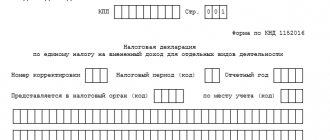What is a cumulative total when calculating income tax?
The tax base for income tax is the monetary expression of the organization's profit (clause 1 of Article 274 of the Tax Code of the Russian Federation).
When determining the tax base, taxable profit is determined on an accrual basis from the beginning of the tax period (clause 7 of Article 274 of the Tax Code of the Russian Federation). Tax is calculated based on the annual base.
Advances based on the results of reporting periods are calculated based on profits calculated on an accrual basis from the beginning of the tax period to the end of the reporting period (clause 2 of Article 286 of the Tax Code of the Russian Federation). Cumulative total means that the profit of the reporting quarter is determined based on income and expenses received/incurred from the beginning of the year to the reporting date. That is, it actually includes both the profit/loss of the previous reporting period and the profit/loss of the current one.
Find out how to correctly calculate advance payments for income tax in ConsultantPlus. If you don't have access to the system, get a free trial online.
About the cumulative total in another report, read the material “6-NDFL is filled in with a cumulative total from the beginning of the year.”
Advance payments in the income tax return
Algorithm for calculating advance payments
Difficulties in filling out “advance” lines arise for taxpayers with reporting periods of 1 quarter, half a year, and 9 months.
It seems that everything is simply written in paragraph 2 of Art. 286 Tax Code of the Russian Federation:
1) at the end of each reporting (tax) period, taxpayers calculate the amount of the advance payment based on the tax rate and profit subject to taxation, calculated on an accrual basis from the beginning of the tax period to the end of the reporting (tax) period;
2) during the reporting period, taxpayers calculate the amount of the monthly advance payment:
— the amount of the monthly advance payment payable in the first quarter of the current tax period is taken equal to the amount of the monthly advance payment payable by the taxpayer in the last quarter of the previous tax period;
— the amount of the monthly advance payment payable in the second quarter of the current tax period is taken equal to one third of the amount of the advance payment calculated for the first reporting period of the current year;
— the amount of the monthly advance payment payable in the third quarter of the current tax period is taken equal to one third of the difference between the amount of the advance payment calculated based on the results of the six months and the amount of the advance payment calculated based on the results of the first quarter;
— the amount of the monthly advance payment payable in the fourth quarter of the current tax period is taken equal to one third of the difference between the amount of the advance payment calculated based on the results of nine months and the amount of the advance payment calculated based on the results of the six months;
3) if the amount of the monthly advance payment calculated in this way is negative or equal to zero, these payments are not made in the corresponding quarter.
In other words, in order to determine the amount of tax to be paid additionally (or reduced) based on the results of the reporting (tax) period, it is necessary to subtract the amount of previously accrued advance payments from the amount of tax calculated for the reporting period:
— for the previous reporting period;
— (and) monthly payments calculated for payment by the months of the last quarter of the reporting period.
What is the problem
Problems begin when filling out subsections 1.1 and 1.2 of section 1 “Amount of tax payable to the budget according to the taxpayer.”
Perhaps the problem lies in the “florid” wording of clause 4.2.1 of the Procedure for filling out a tax return for income tax, approved. By order of the Federal Tax Service of Russia dated March 22, 2012 N ММВ-7-3/ [email protected]
So, we read the order of filling out subsection 1.1 of section 1:
— line 040 indicates the amount of income tax to be paid additionally to the federal budget, determined by subtracting from line 190 the indicators of lines 220 and 250 of Sheet 02. This indicator is indicated if the indicator of line 190 exceeds the sum of lines 220 and 250 of Sheet 02 (line 190 - line 220 - line 250, if line 190 is greater than the sum of lines 220 and 250);
— line 050 indicates the amount of income tax to be reduced to the federal budget, defined as the difference in the sum of lines 220, 250 and line 190 of Sheet 02. This indicator is indicated if the indicator of line 190 is less than the sum of lines 220 and 250 of Sheet 02 ((line 220 + line 250) - line 190, if the indicator of line 190 is less than the sum of the indicators of lines 220 and 250);
— line 070 indicates the amount of income tax to be paid additionally to the budget of the constituent entity of the Russian Federation, determined by subtracting from line 200 the indicators of lines 230 and 260 of Sheet 02. This indicator is indicated if the indicator of line 200 exceeds the sum of lines 230 and 260 of Sheet 02 (line 200 - line 230 - line 260, if line 200 is greater than the sum of lines 230 and 260);
— line 080 indicates the amount of income tax to be reduced to the budget of the constituent entity of the Russian Federation, defined as the difference in the sum of lines 230, 260 and line 200 of Sheet 02. This indicator is indicated if the indicator of line 200 is less than the sum of lines 230 and 260 of Sheet 02 ((line 230 + line 260) - line 200, if line 200 is less than the sum of lines 230 and 260).
It is not entirely clear why it is so difficult to write, if in fact all arithmetic operations are performed directly on Sheet 02 of the declaration, and the required result (tax to be paid additionally or to be reduced by budget) is obtained precisely on this sheet.
In an adapted version, the above text looks like this:
— the indicator from line 270 of Sheet 02 (the amount of tax to be paid additionally to the federal budget) is transferred to line 040 of subsection 1.1;
— the indicator from line 271 of Sheet 02 is transferred to line 070 of subsection 1.1 (the amount of tax to be paid additionally to the budget of the constituent entity of the Russian Federation);
— the indicator from line 280 of Sheet 02 (the amount of tax to be reduced to the federal budget) is transferred to line 050 of subsection 1.1;
— the indicator from line 281 of Sheet 02 (the amount of tax to be reduced to the budget of the constituent entity of the Russian Federation) is transferred to line 080 of subsection 1.1.
The procedure for filling out subsection 1.2 is described in clause 4.3 quite clearly and does not require adaptation:
— lines 120, 130, 140 reflect the amounts of monthly advance payments payable to the federal budget, and are determined as one third of the amount indicated on lines 300 or 330 of Sheet 02;
— lines 220, 230, 240 reflect the amounts of monthly advance payments payable to the budget of the constituent entity of the Russian Federation, and are defined as one third of the amount indicated on lines 310 or 340 of Sheet 02.
Example
As an example, we took numbers from a letter from our reader. Based on them, we filled out subsections 1.1 and 1.2 of section 1, as well as the corresponding lines of sheets 02 of income tax returns for the reporting periods of 2013.
Organizational profit tax by reporting periods:
- for the 1st quarter of 2013 - 466 rubles:
— for the first half of 2013 – 3,020 rubles;
- for 9 months of 2013 - 894 rubles.
Advance payments for payment in the 1st quarter of 2013 were not accrued in the declaration for 9 months of 2012, since the organization had losses in the 3rd quarter of 2012.
Below is a summary table of tax return indicators. The same table and completed subsections 1.1 and 1.2 of section 1, lines of sheets 02 of income tax returns for the reporting periods of 2013, see the attached files for downloading.
| Index | Line code | Tax return for the reporting period 2013: | |||
| 1 quarter | 6 months | 9 months | |||
| Section 1, subsection 1.1 | |||||
| To the federal budget Amount of tax to be paid additionally (from line 270 of Sheet 02) Tax amount to be reduced (from line 280 of Sheet 02) | 040 | 47 | 208 | — | |
| 050 | — | — | 468 | ||
| To the budget of a constituent entity of the Russian Federation Amount of tax to be paid additionally (from line 271 of Sheet 02) Tax amount to be reduced (from line 281 of Sheet 02) | 070 | 419 | 1 880 | — | |
| 080 | — | — | 4 212 | ||
| Section 1, subsection 1.2 | |||||
| The quarter for which monthly advance payments are calculated (code “24” means the 4th quarter of the current year) | X | X | X | 24 | |
| To the federal budget (line 300 of Sheet 02:3) Amount of monthly advance payment for 1 term Amount of monthly advance payment for term 2 Amount of monthly advance payment for the 3rd term | 120 | 16 | 85 | — | |
| 130 | 16 | 85 | — | ||
| 140 | 15 | 85 | — | ||
| To the budget of a constituent entity of the Russian Federation (line 310 of Sheet 02:3) Amount of monthly advance payment for 1 term Amount of monthly advance payment for term 2 Amount of monthly advance payment for the 3rd term | 220 | 140 | 767 | — | |
| 230 | 140 | 766 | — | ||
| 240 | 139 | 766 | — | ||
| Section 1, subsection 1.2 (with quarter code “21”) filled out only in the declaration for 9 months | |||||
| The quarter for which monthly advance payments are calculated (code “21” means the 1st quarter of the next year) | X | X | X | 21 | |
| To the federal budget (line 330 of Sheet 02:3) Amount of monthly advance payment for 1 term Amount of monthly advance payment for term 2 Amount of monthly advance payment for the 3rd term | 120 | X | X | — | |
| 130 | X | X | — | ||
| 140 | X | X | — | ||
| To the budget of a constituent entity of the Russian Federation (line 340 of Sheet 02:3) Amount of monthly advance payment for 1 term Amount of monthly advance payment for term 2 Amount of monthly advance payment for the 3rd term | 220 | X | X | — | |
| 230 | X | X | — | ||
| 240 | X | X | — | ||
| Sheet 02 | |||||
| Amount of calculated income tax, total | 180 | 466 | 3 020 | 894 | |
| incl. to the federal budget | 190 | 47 | 302 | 89 | |
| to the budget of a constituent entity of the Russian Federation | 200 | 419 | 2 718 | 805 | |
| Amount of accrued advance payments for the reporting (tax) period - total | 210 | — | 932 | 5 574 | |
| incl. to the federal budget (tax amount calculated for the quarter) | 220 | — | 94 (47 + 47) | 557 (302 + 255) | |
| to the budget of a constituent entity of the Russian Federation (tax amount calculated for the quarter) | 230 | — | 838 (419 + 419) | 5 017 (2718 + 2299) | |
| Amount of income tax to be paid additionally to the federal budget (line 190 – line 220) to the budget of a constituent entity of the Russian Federation (line 200 – line 230) | 270 | 47 | 208 | — | |
| 271 | 419 | 1 880 | — | ||
| The amount of income tax to be reduced to the federal budget (line 220 – line 190) to the budget of a constituent entity of the Russian Federation (line 230 – line 200) | 280 | — | — | 468 | |
| 281 | — | — | 4 212 | ||
| The amount of monthly advance payments due in the quarter following the current reporting period | 290 | 466 | 2 554 | — | |
| incl. to the federal budget | 300 | 47 | 255 (302 – 47) | — | |
| to the budget of a constituent entity of the Russian Federation | 310 | 419 | 2 299 (2 718 – 419) | — | |
| Amount of monthly advance payments due in the 1st quarter of the next tax period | 320 | — | — | — | |
| incl. to the federal budget | 330 | — | — | — | |
| to the budget of a constituent entity of the Russian Federation | 340 | — | — | — | |
Example of tax base calculation
Let us explain this with an example.
Let's say the reporting periods for an organization are quarter, six months and 9 months.
For the first quarter, its income amounted to 900 thousand rubles, and expenses - 750 thousand rubles.
For the second quarter: income - 600 thousand, expenses 800 thousand rubles, respectively.
For the third quarter: 1 million and 700 thousand rubles.
For the fourth quarter - 700 thousand and 800 thousand.
Let's present the calculation of the tax base in the table:
| I quarter | Half year | 9 months | Year | |
| Revenues, thousand | 900 | 1500 (900 + 600) | 2500 (900 + 600 + 1 000) | 3200 (900 + 600 + 1000 + 700) |
| Expenses, thousand | 750 | 1550 (750 + 800) | 2250 (750 + 800 + 700) | 3050 (750 + 800 + 700 + 800) |
| Financial results, thousand | +150 | -50 | +250 | +150 |
Thus, during the year the organization received both profit and loss, but as a result, the cumulative total was a profit.
See also: “How is profit before tax calculated (formula)?”
What are advance payments?
The amount of the advance payment is calculated not from actual income, but based on data from the past quarter.
Monthly payments are made by enterprises whose average income was above 15 million rubles over the previous 4 quarters. Such payments can be made in any form until the 28th of each month.
The base interest rate applied to income tax is no more than 20% and depends on the territorial location of the organization in a given region.
Companies whose average revenue is less than this amount based on the last four quarters are allowed to make advance payments quarterly. They are calculated from income actually received, the advance is transferred in the last month of each quarter, but no later than the 28th.
Let's look at an example of how to calculate an advance payment for income tax. But before getting down to business, it would be a good idea to find out how the company is obliged to make payments quarterly or every month. How to make a calculation?
- Calculate the tax base from the cumulative results of each of the last four quarters.
- Display the quarterly average. To do this, you need to add all the indicators and divide by four. If the tax base turns out to be above 15 million rubles, then contributions will have to be paid monthly, if not, quarterly.
Advance payments for income tax: calculation example
For the first quarter, the profit subject to taxation of Profi Plus LLC amounted to 12 million rubles.
Calculation of quarterly payment: 12 million rubles. x 20% to the transfer of 2.4 million rubles. The amount of the advance payment is found as the difference between 2.4 million rubles of the quarterly payment and the amount of monthly contributions already deducted. Since there were none, the entire amount must be paid in the first quarter.
In the second quarter, an advance payment was made - 800 thousand rubles (2.4 million rubles: 3).
- The tax base calculated for the six months is 30 million rubles.
- This means that the payment amount for the quarter will be 6 million rubles (30 million rubles x 20%).
- Additional payment for 6 months 1.2 million rubles: (6 -2.4 -800 x 3).
In the third quarter, the advance payment for the month will be 1.2 million rubles (6 million rubles – 2.4 million rubles: 3).
- For the first 9 months, taxable profit is calculated in the amount of 41.0 million rubles. Therefore, the advance payment will be equal to 8.2 million rubles (41.0 million rubles x 20%).
- As a result, the company overpaid 1.4 million rubles (8.2 million rubles - 6.0 - 1.2 million rubles x 3).
When an enterprise does not make monthly payments, the tax base is calculated on an accrual basis on a quarterly basis. The established interest rate is applied to it to calculate the advance payment.
When calculating contributions for 6 and 9 months, an offset mechanism is used, thanks to which payments transferred earlier are taken into account when calculating quarterly amounts.
Reflection of wages in expenses
In the meantime, let’s take into account another type of expense – labor costs. To do this, we will create a document “Reflection of salaries in accounting” (Fig. 8).
Fig.8
When conducting, both accounting and tax entries are also generated (Fig. 9).
Fig.9
Write-off of materials for production and release of products
Now let’s write off the necessary materials for production (Fig. 10).
Fig.10
In the entries we see the amounts for both accounting and tax accounting (Fig. 11).
Fig.11
It remains to reflect the production and sales of products.
Figure 12 shows the postings generated by the document “Production Report for a Shift”. The main thing to remember is that the amount in the transactions depends on the planned price set in advance and has no direct connection with actual expenses.
Fig.12
The last document in our chain – “Sales (act, invoice)” – reflects the sale of all manufactured products (Fig. 13) and forms our income.
Fig.13
So, all planned expenses and income have been taken into account. You can start calculating your income tax. This is the second and final stage of tax calculation in 1C.
Depreciation
We will complete the closing in three months – January, February and March. In February (Fig. 14), that is, next after the equipment is accepted for accounting, operations will be carried out to account for the depreciation bonus.
Fig.14
Figure 15 shows depreciation entries. The depreciation bonus “edited” the depreciation amount for tax accounting, resulting in temporary differences.
Fig.15
What's in the declaration?
The income tax return is also drawn up on an accrual basis from the beginning of the year (clause 2.1 of the Completion Procedure, approved by order of the Federal Tax Service of Russia dated September 23, 2019 No. ММВ-7-3/ [email protected] ).
Important! The declaration for 2021 must be submitted using a new form.
In it you reflect the income and expenses accumulated from January 1 to the reporting date, and the amount of tax or advance payment calculated from them.
The amount of tax (advance) payable is shown minus payments of the previous reporting period. As a result, the difference between the current payment and the payment of the previous reporting period goes to the budget.
If you have access to ConsultantPlus, check whether you have filled out your income tax return correctly. If you don't have access, get a free trial of online legal access.
Find recommendations for preparing and an example of filling out an income tax return here.
How to calculate profit for the year: differences between the tax indicator and the accounting indicator
To calculate the amount of income tax for the year, we must determine the taxable base (TB) in accordance with the requirements of Art. 247 of the Tax Code of the Russian Federation as the difference between income (D) and expenses (R) for January-December 2021:
NB = D – R
We are accustomed to calling the NB indicator tax profit, the size of which determines the amount of income tax. In this case, indicators D and P are determined according to the norms of tax legislation.
The formation of accounting profit is based on one of the basic rules of accounting - a continuous continuous documentary reflection of all the facts of the company's economic activity. All types of income received and expenses incurred are subject to accounting, regardless of the tax nuances of calculating NB (the impossibility of taking into account certain types of expenses, differences in methods of calculating depreciation, restrictions on their size for the purposes of calculating income tax, etc.).
Find out how information about the company’s activities is reflected in the accounting accounts from the publication.
To reflect in accounting and reporting the difference between accounting and tax profit, there are special values and methods of their application, described in PBU 18/02 “Accounting for calculations of corporate income tax,” approved. by order of the Ministry of Finance of the Russian Federation dated November 19, 2002 No. 114n (deferred tax assets and liabilities, conditional income tax expense (income), etc.).
For those who may not apply PBU 18/02, we will tell you in the article.
Results
Calculation of tax on an accrual basis means that the calculation must be based on income and expenses received (made) from January 1 to the reporting date. The tax return is filled out using the same principle. The amount of tax payable also increases, since when determining it, payments from previous reporting periods are taken into account.
You can find more complete information on the topic in ConsultantPlus. Free trial access to the system for 2 days.
How to calculate a sum in an Excel table quickly and easily? Try different methods: look at the sum of selected cells in the status bar, use AutoSum to add all or just a few individual cells, use the SUM function, or convert your range into a smart table for easy calculations. We will show all this with examples.
Content
How to determine the amount of profit for tax purposes?
To form a national bank and subsequently calculate income tax, you must:
- have properly executed primary documents for each income and expense accounted for in the National Bank;
- organize grouping and generalization of data on income and expenses in special tax registers.
How to develop tax registers for income tax, see the publication.
Income and expenses must be determined in accordance with the accounting policies adopted by the company.
We'll tell you how to draw up the tax section of your accounting policy.
To calculate the NB, use the tips from the table below:
| Sequence for determining NB | Article of the Tax Code of the Russian Federation | Hints |
| Sum up sales income and non-operating income | Art. 249–250 | We’ll tell you whether overdue creditors and gratuitously received property are taken into account in your income. |
| Exclude income that is not recognized for tax purposes from all receipts. | Art. 251 | Find out about the features of tax accounting of income from the publication |
| Evaluate each expense for the possibility of taking them into account when calculating the NB, taking into account the basic principles - validity and documentary evidence of the expense | Art. 252–269 | Are taxi costs taken into account when calculating income tax, see the article |
| Do not include as expenses expenses that are not recognized when calculating income tax. | Art. 270 | We will tell you in the publication whether fines and voluntary insurance contributions affect the reduction of profits |
| Check the standard expenses (advertising, hospitality, etc.) | Art. 264 | A message to help you |
| Specify the amount of non-operating expenses taken into account when calculating income tax | Art. 265 | Find out what documents help you take into account fire losses as part of non-operating expenses |
| Calculate NB | Art. 274–283 | We will tell you about the nuances of calculating NB for income tax in the article |
| If you received losses in previous years, take them into account when calculating the NB - remember that the current year's NB can be reduced by the amount of the loss by no more than 50% | Art. 283 | How the Tax Code of the Russian Federation interprets tax loss, we will tell you in the material |
See below for an example of calculating profit for the year.
How to calculate the amount with one click.
Let's say you have a table that records revenue for several departments. You need to quickly look at the total sales for one of them.
Simply click on a column letter and look at the Microsoft Excel status bar to see the total number of selected cells and the sum of their values.
Being very fast, this method does not allow you to copy the final numbers - you can only look at them.
Determining the amount of income tax (example)
Let's consider an example of calculating income tax for the year and the profit itself, which is the basis for calculating this tax.
Industrial Technologies LLC applies OSNO and pays income tax. At the end of 2021, specialists from Industrial Technologies LLC calculated the company’s tax profit based on the following indicators:
- revenue from the sale of works (services) - RUB 7,458,231;
- non-operating income - 527,000 rubles;
- costs associated with production and sales - RUB 6,349,354, including:
— material costs — 2,897,562 rubles;
— depreciation of fixed assets — 287,320 rubles;
— labor costs and insurance premiums — RUB 3,164,472;
- other expenses - RUB 1,547,262, including:
— advertising expenses (advertising on vehicles) — RUB 189,300;
— other miscellaneous expenses — RUB 1,357,962.
Calculation: NB2017=(7,458,231+527,000) – (6,349,354+1,547,262 – 114,718)=RUB 203,333,
Where:
114,718 - the amount of advertising expenses that did not meet the limit of 1% of revenue at the end of the year (RUB 189,300 - RUB 7,458,231 × 1% = RUB 114,718).
Find out why advertising on transport is regulated in this article.
In 2021, Industrial Technologies LLC received a tax loss in the amount of 312,988 rubles, so the company’s specialists adjusted the NB2017 for the amount of the loss and calculated the income tax:
Income tax =(RUB 203,333 – RUB 101,667) × 20%=RUB 20,333,
Where:
RUB 101,667 - the maximum amount of loss by which the profit of 2021 can be reduced according to the norms of Art. 283 of the Tax Code of the Russian Federation (203,333 rubles × 50% = 101,667 rubles).
The remaining loss in the amount of RUB 211,321. (RUB 312,988 – RUB 101,667) is carried forward to future periods.
What is AutoSum in an Excel table?
The second simplest method is auto-summation. Place the cursor where you want to see the calculation, and then use the "AutoSum" button on the Home tab, or the ALT + = .
The SUM function appears in the active cell with links to adjacent cells. Excel will try to guess what exactly you want to do. Press ENTER to finish entering the formula.
And if there are no numbers suitable for calculation nearby, then you will simply be prompted to indicate the calculation area yourself.
=SUM()
This method is fast and allows you to automatically obtain and save the result.
In addition, ALT + = to quickly put a formula in an Excel cell without having to enter it manually. Agree, this little hack in Excel can greatly speed up your work.
And if you need to quickly calculate vertical and horizontal totals, then auto-sum can also help here. Watch this short video to find out how.
Below the video, just in case, there is a short explanation.
So, select a range of cells and additionally a row of empty cells below and to the right (that is, B2:E14 in the example given).
Click the AutoSum button on the Home tab of the ribbon. The addition formula will be entered immediately.
Entering the SUM function manually.
The most traditional way to create a formula in MS Excel is to enter the function from the keyboard. As usual, select the desired cell and enter the = sign. Then we start typing SUM. The first letter “C” will open a list of available functions, from which you can immediately select the one you need.
Now define the range of numbers you want to add using the mouse or simply enter it from the keyboard. If you have a large data area for calculations, then, of course, it will be much easier to specify it manually (for example, B2:B300). Press Enter.
So, your range has been summed up, and you see the result in the selected cell. I think you understand that exactly the same thing needs to be done to calculate it by line.
Rules for using the sum formula in Excel (syntax):
SUM(number1; [number2]; ...)
It has one required argument: number1.
There are also optional arguments (enclosed in square brackets): [number2], ..
They can be numbers, cell references, ranges, arrays, and constants in any combination. Up to 255 individual arguments can be processed.
For example, in the expression =SUM(D2:D13) there is only one argument - a reference to cells D2:D13.
By the way, in this case it is also possible to use auto-summation.
Cumulative value, or cumulative total.
Task: After each month, you need to automatically determine the profit earned since the beginning of the year. It will change every month depending on the result achieved.
Watch this short video, and then we will explain all our actions.
In cell C2 write the formula
=SUM(B$2:B2)
Please note that we used an absolute reference to row 2 in the first address. That is, when copying a cell with a formula, we will always start from the 2nd row.
Place the cursor in the lower right corner of the cell and drag it to C13. As a result, our formula will be copied throughout the selection. And the starting address B$2 will not change. For example, in C13 it looks like this: =SUM(B$2:B13).
As you can see, the cumulative total either increases or decreases depending on the results of the past month.









